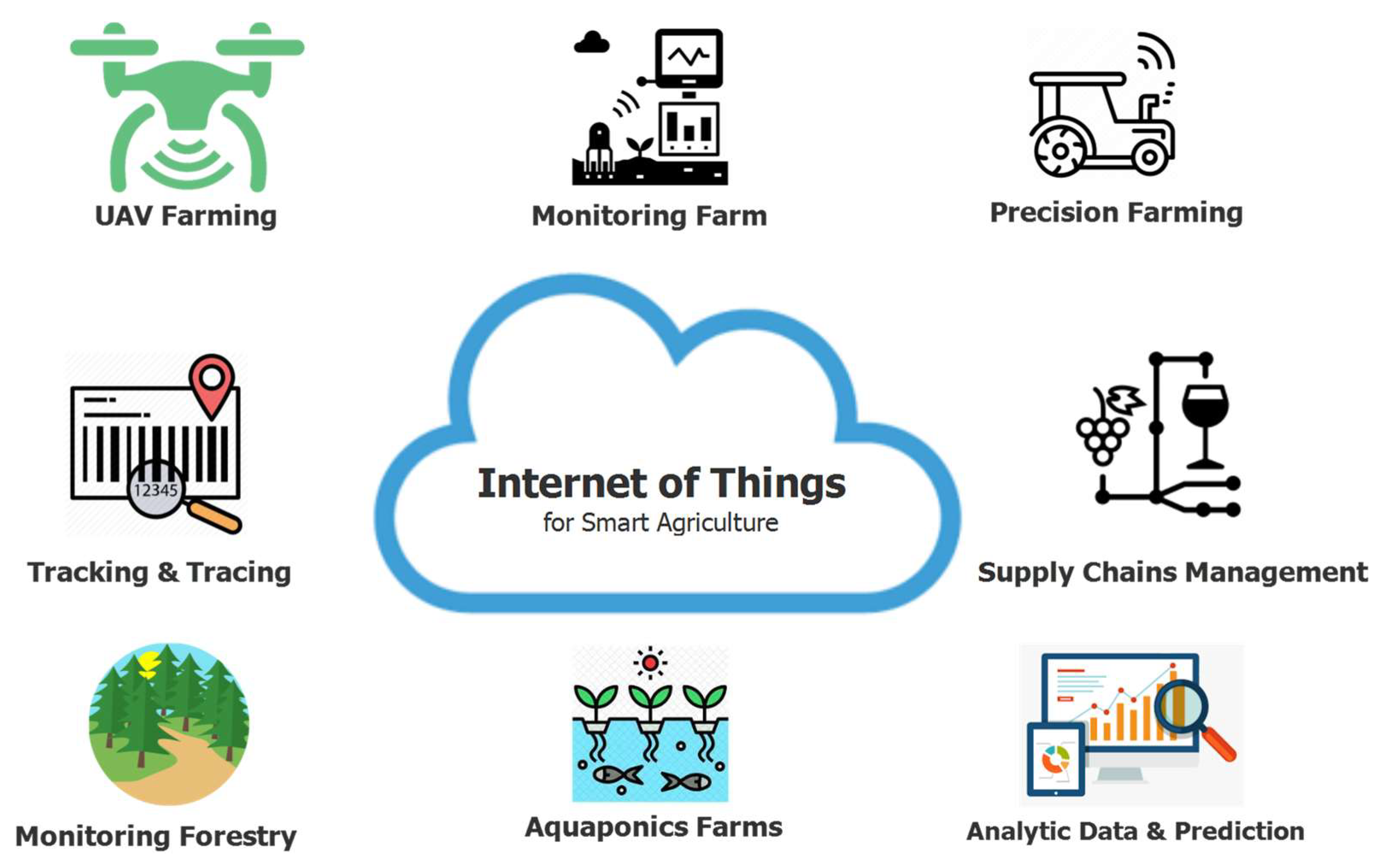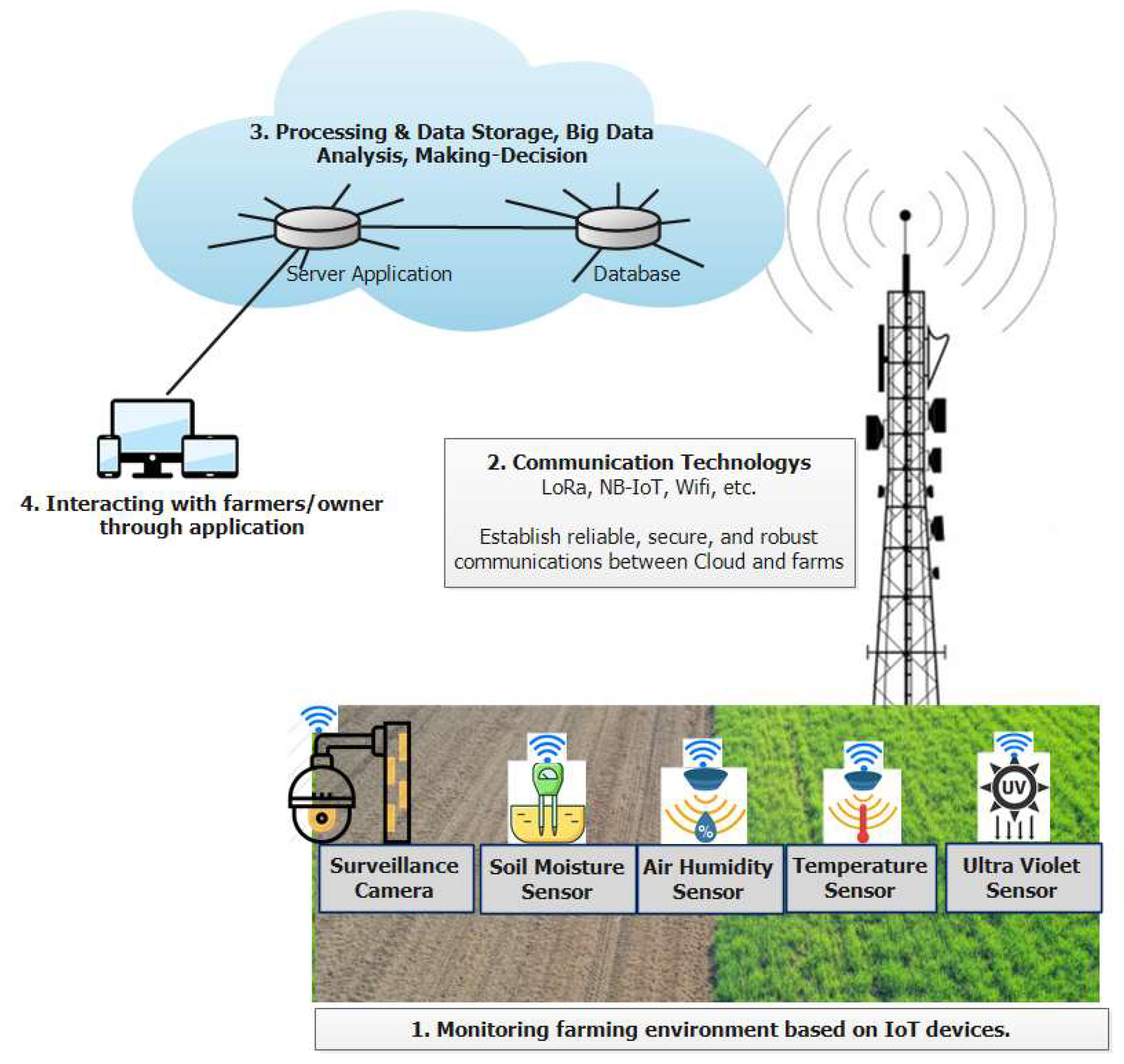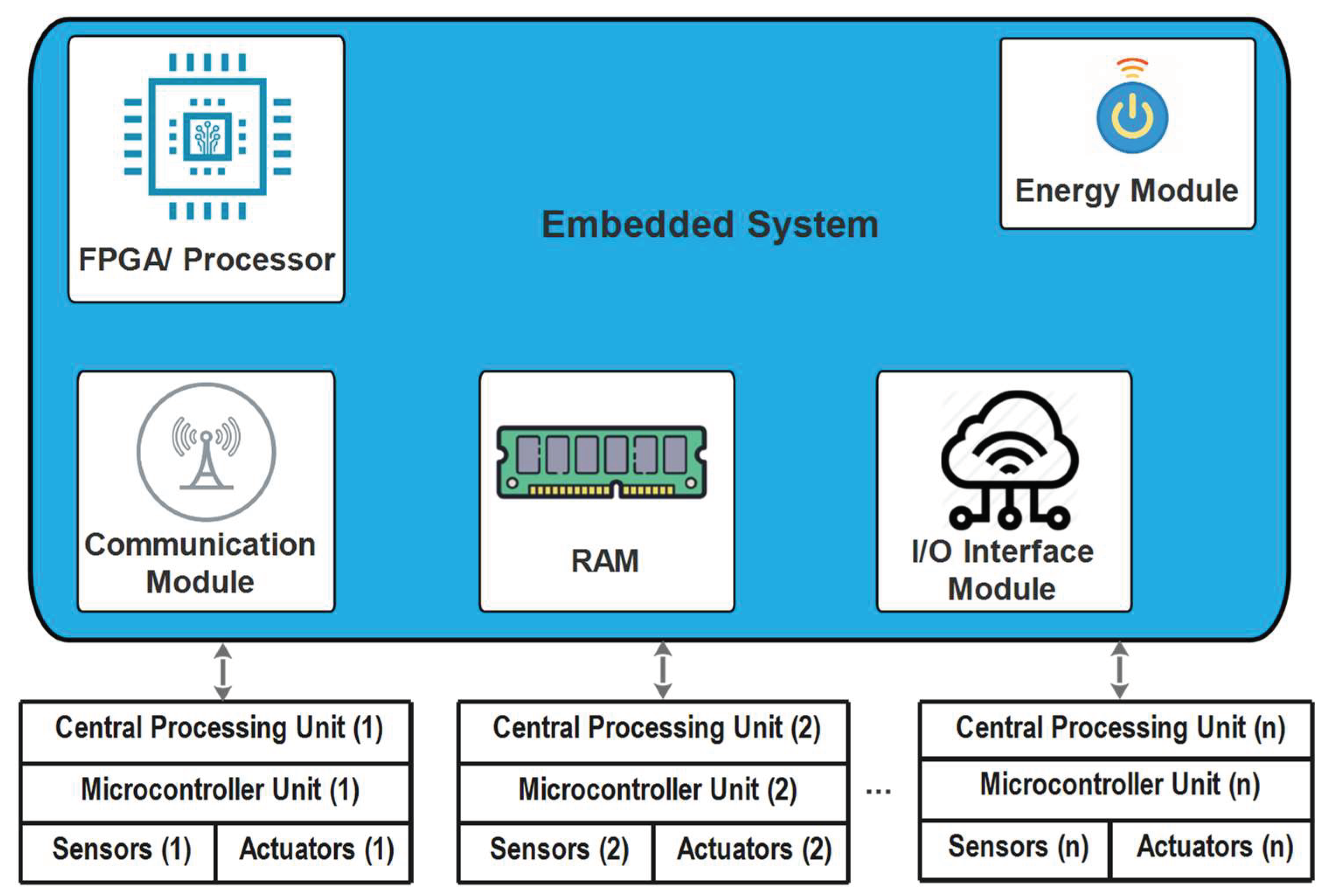
| Version | Summary | Created by | Modification | Content Size | Created at | Operation |
|---|---|---|---|---|---|---|
| 1 | Quy Khanh Vu | + 2297 word(s) | 2297 | 2022-03-28 05:13:29 | | | |
| 2 | Catherine Yang | -8 word(s) | 2289 | 2022-03-28 10:18:09 | | | | |
| 3 | Catherine Yang | Meta information modification | 2289 | 2022-03-31 04:34:22 | | | | |
| 4 | Catherine Yang | + 44 word(s) | 2333 | 2022-04-01 11:25:20 | | |
Video Upload Options
The growth of the global population coupled with a decline in natural resources, farmland, and the increase in unpredictable environmental conditions leads to food security is becoming a major concern for all nations worldwide. These problems are motivators that are driving the agricultural industry to transition to smart agriculture with the application of the Internet of Things (IoT) and big data solutions to improve operational efficiency and productivity. The IoT integrates a series of existing state-of-the-art solutions and technologies, such as wireless sensor networks, cognitive radio ad hoc networks, cloud computing, big data, and end-user applications. IoT is defined as the network of all objects that are embedded within devices, sensors, machines, software and people through the Internet environment to communicate, exchange information and interact in order to provide a comprehensive solution between the real world and the virtual world.
1. Introduction

2. Typical Applications of IoT in Smart Agriculture
2.1. Monitoring
2.2. Tracking and Tracing
2.3. Smart Precision Farming

2.4. Greenhouse Production

References
- Quy, V.K.; Nam, V.H.; Linh, D.M.; Ngoc, L.A.; Gwanggil, J. Wireless Communication Technologies for IoT in 5G: Vision, Applications, and Challenges. Wirel. Commun. Mob. Comput. 2022, 2022, 3229294.
- Sinche, S.; Raposo, D.; Armando, N.; Rodrigues, A.; Boavida, F.; Pereira, V.; Silva, J.S. A Survey of IoT Management Protocols and Frameworks. IEEE Commun. Surv. Tutor. 2020, 22, 1168–1190.
- Elijah, O.; Rahman, T.A.; Orikumhi, I.; Leow, C.Y.; Hindia, M.N. An Overview of Internet of Things (IoT) and Data Analytics in Agriculture: Benefits and Challenges. IEEE Internet Things J. 2018, 5, 3758–3773.
- Li, W.; Logenthiran, T.; Phan, V.; Woo, W.L. A Novel Smart Energy Theft System (SETS) for IoT-based Smart Home. IEEE Internet Things J. 2019, 6, 5531–5539.
- Shin, D.; Yun, K.; Kim, J.; Astillo, P.V.; Kim, J.-N.; You, I. A Security Protocol for Route Optimization in DMM-Based Smart Home IoT Networks. IEEE Access 2019, 7, 142531–142550.
- An, J.G.; Le Gall, F.; Kim, J.; Yun, J.; Hwang, J.; Bauer, M.; Zhao, M.; Song, J.S. Toward Global IoT-Enabled Smart Cities Interworking Using Adaptive Semantic Adapter. IEEE Internet Things J. 2019, 6, 5753–5765.
- Cirillo, F.; Gomez, D.; Diez, L.; Maestro, I.E.; Gilbert, T.B.J.; Akhavan, R. Smart City IoT Services Creation through Large-Scale Collaboration. IEEE Internet Things J. 2020, 7, 5267–5275.
- Ammad, M.; Shah, M.A.; Islam, S.U.; Maple, C.; Alaulamie, A.A.; Rodrigues, J.J.P.C.; Mussadiq, S.; Tariq, U. A Novel Fog-Based Multi-Level Energy-Efficient Framework for IoT-Enabled Smart Environments. IEEE Access 2020, 8, 150010–150026.
- Metallidou, C.K.; Psannis, K.E.; Egyptiadou, E.A. Energy Efficiency in Smart Buildings: IoT Approaches. IEEE Access 2020, 8, 63679–63699.
- Quy, V.K.; Nam, V.H.; Linh, D.M.; Ban, N.T.; Han, N.D. Communication Solutions for Vehicle Ad-hoc Network in Smart Cities Environment: A Comprehensive Survey. Wirel. Pers. Commun. 2022, 122, 2791–2815.
- Kiani, F.; Seyyedabbasi, A.; Nematzadeh, S.; Candan, F.; Çevik, T.; Anka, F.A.; Randazzo, G.; Lanza, S.; Muzirafuti, A. Adaptive Metaheuristic-Based Methods for Autonomous Robot Path Planning: Sustainable Ag-ricultural Applications. Appl. Sci. 2022, 12, 943.
- Patle, K.S.; Saini, R.; Kumar, A.; Palaparthy, V.S. Field Evaluation of Smart Sensor System for Plant Disease Prediction Using LSTM Network. IEEE Sens. J. 2022, 22, 3715–3725.
- Vangala, A.; Das, A.K.; Kumar, N.; Alazab, M. Smart Secure Sensing for IoT-Based Agriculture: Blockchain Perspective. IEEE Sens. J. 2020, 21, 17591–17607.
- Citoni, B.; Fioranelli, F.; Imran, M.A.; Abbasi, Q.H. Internet of Things and LoRaWAN-Enabled Future Smart Farming. IEEE Internet Things Mag. 2019, 2, 14–19.
- Kumar, R.; Mishra, R.; Gupta, H.P.; Dutta, T. Smart Sensing for Agriculture: Applications, Advancements, and Challenges. IEEE Consum. Electron. Mag. 2021, 10, 51–56.
- Chang, Y.; Lai, Y. Campus Edge Computing Network Based on IoT Street Lighting Nodes. IEEE Syst. J. 2020, 14, 164–171.
- Sutjarittham, T.; Habibi Gharakheili, H.; Kanhere, S.S.; Sivaraman, V. Experiences with IoT and AI in a Smart Campus for Optimizing Classroom Usage. IEEE Internet Things J. 2019, 6, 7595–7607.
- Rani, S.; Ahmed, S.H.; Shah, S.C. Smart Health: A Novel Paradigm to Control the Chickungunya Virus. IEEE Internet Things J. 2019, 6, 1306–1311.
- Zhou, Z.; Yu, H.; Shi, H. Human Activity Recognition Based on Improved Bayesian Convolution Network to Analyze Health Care Data Using Wearable IoT Device. IEEE Access 2020, 8, 86411–86418.
- Humayun, M.; Jhanjhi, N.; Hamid, B.; Ahmed, G. Emerging Smart Logistics and Transportation Using IoT and Blockchain. IEEE Internet Things Mag. 2020, 3, 58–62.
- Song, Y.; Yu, F.R.; Zhou, L.; Yang, X.; He, Z. Applications of the Internet of Things (IoT) in Smart Logistics: A Comprehensive Survey. IEEE Internet Things J. 2021, 8, 4250–4274.
- Shafique, K.; Khawaja, B.A.; Sabir, F.; Qazi, S.; Mustaqim, M. Internet of Things (IoT) for Next-Generation Smart Systems: A Review of Current Challenges, Future Trends & Prospects for Emerging 5G-IoT Scenarios. IEEE Access 2020, 8, 23022–23040.
- Available online: https://www.un.org/development/desa/en/news/population/world-population-prospects-2019.html (accessed on 7 May 2021).
- Yang, X.; Shu, L.; Chen, J.; Ferrag, M.A.; Wu, J.; Nurellari, E.; Huang, K. A Survey on Smart Agriculture: Development Modes, Technologies, and Security and Privacy Challenges. IEEE/CAA J. Autom. Sin. 2021, 8, 273–302.
- Ayaz, M.; Ammad-Uddin, M.; Sharif, Z.; Mansour, A.; Aggoune, E.-H.M. Internet-of-Things (IoT)-Based Smart Agriculture: Toward Making the Fields Talk. IEEE Access 2019, 7, 129551–129583.
- Alfred, R.; Obit, J.H.; Chin, C.P.-Y.; Haviluddin, H.; Lim, Y. Towards Paddy Rice Smart Farming: A Review on Big Data, Machine Learning, and Rice Production Tasks. IEEE Access 2021, 9, 50358–50380.
- Zikria, Y.B.; Ali, R.; Afzal, M.K.; Kim, S.W. Next-Generation Internet of Things (IoT): Opportunities, Challenges, and Solutions. Sensors 2021, 21, 1174.
- Kour, V.P.; Arora, S. Recent Developments of the Internet of Things in Agriculture: A Survey. IEEE Access 2020, 8, 129924–129957.
- Saad, A.; Benyamina, A.E.H.; Gamatié, A. Water Management in Agriculture: A Survey on Current Challenges and Technological Solutions. IEEE Access 2020, 8, 38082–38097.
- Tyagi, S.K.S.; Mukherjee, A.; Pokhrel, S.R.; Hiran, K.K. An Intelligent and Optimal Resource Allocation Approach in Sensor Networks for Smart Agri-IoT. IEEE Sens. J. 2020, 21, 17439–17446.
- Li, X.; Pu, T.; Li, L.; Ao, J. Enhanced Sensitivity of GaN-Based Temperature Sensor by Using the Series Schottky Barrier Diode Structure. IEEE Electron Device Lett. 2020, 41, 601–604.
- Gopalakrishnan, S.; Waimin, J.; Raghunathan, N.; Bagchi, S.; Shakouri, A.; Rahimi, R. Battery-Less Wireless Chipless Sensor Tag for Subsoil Moisture Monitoring. IEEE Sens. J. 2021, 21, 6071–6082.
- Udutalapally, V.; Mohanty, S.P.; Pallagani, V.; Khandelwal, V. sCrop: A Novel Device for Sustainable Automatic Disease Prediction, Crop Selection, and Irrigation in Internet-of-Agro-Things for Smart Agriculture. IEEE Sens. J. 2020, 21, 17525–17538.
- Spachos, P.; Gregori, S. Integration of Wireless Sensor Networks and Smart UAVs for Precision Viticulture. IEEE Internet Comput. 2019, 23, 8–16.
- Abdelnour, A.; Buchin, F.; Kaddour, D.; Tedjini, S. Improved Traceability Solution Based on UHF RFID for Cheese Production Sector. IEEE J. Radio Freq. Identif. 2018, 2, 68–72.
- Friha, O.; Ferrag, M.A.; Shu, L.; Maglaras, L.; Wang, X. Internet of Things for the Future of Smart Agriculture: A Comprehensive Survey of Emerging Technologies. IEEE/CAA J. Autom. Sin. 2021, 8, 718–752.
- Farooq, M.S.; Riaz, S.; Abid, A.; Abid, K.; Naeem, M.A. A Survey on the Role of IoT in Agriculture for the Implementation of Smart Farming. IEEE Access 2019, 7, 156237–156271.
- Sengupta, A.; Debnath, B.; Das, A.; De, D. FarmFox: A Quad-Sensor based IoT box for Precision Agriculture. IEEE Consum. Electron. Mag. 2021, 10, 63–68.
- Kaiyi, L.; Hengyuan, K.; Huansheng, M.; Fan, Z. Design of a New Generation of Weather Radar Intelligent Temperature and Humidity Monitoring System Based on ZigBee. In Proceedings of the 2019 International Conference on Meteorology Observations (ICMO), Chengdu, China, 28–31 December 2019; pp. 1–3.
- Dong, Y.; Xu, F.; Liu, L.; Du, X.; Ren, B.; Guo, A.; Geng, Y.; Ruan, C.; Ye, H.; Huang, W.; et al. Automatic System for Crop Pest and Disease Dynamic Monitoring and Early Forecasting. IEEE J. Sel. Top. Appl. Earth Obs. Remote Sens. 2020, 13, 4410–4418.
- Ghandar, A.; Ahmed, A.; Zulfiqar, S.; Hua, Z.; Hanai, M.; Theodoropoulos, G. A Decision Support System for Urban Agriculture Using Digital Twin: A Case Study with Aquaponics. IEEE Access 2021, 9, 35691–35708.
- Pasha, A.K.; Mulyana, E.; Hidayat, C.; Ramdhani, M.A.; Kurahman, O.T.; Adhipradana, M. System Design of Controlling and Monitoring on Aquaponic Based on Internet of Things. In Proceedings of the 2018 4th International Conference on Wireless and Telematics (ICWT), Nusa Dua, Bali, Indonesia, 12–13 July 2018; pp. 1–5.
- Lee, C.; Jhang, J. System Design for Internet of Things Assisted Urban Aquaponics Farming. In Proceedings of the 2019 IEEE 8th Global Conference on Consumer Electronics (GCCE), Osaka, Japan, 15–18 October 2019; pp. 986–987.
- Wei, Y.; Li, W.; An, D.; Li, D.; Jiao, Y.; Wei, Q. Equipment and Intelligent Control System in Aquaponics: A Review. IEEE Access 2019, 7, 169306–169326.
- Marcu, A.-E.; Suciu, G.; Olteanu, E.; Miu, D.; Drosu, A.; Marcu, I. IoT System for Forest Monitoring. In Proceedings of the 42nd International Conference on Telecommunications and Signal Processing (TSP), Budapest, Hungary, 1–3 July 2019; pp. 629–632.
- Zou, W.; Jing, W.; Chen, G.; Lu, Y.; Song, H. A Survey of Big Data Analytics for Smart Forestry. IEEE Access 2019, 7, 46621–46636.
- Chaudhry, A.A.; Mumtaz, R.; Hassan Zaidi, S.M.; Tahir, M.A.; Muzammil School, S.H. Internet of Things (IoT) and Machine Learning (ML) enabled Livestock Monitoring. In Proceedings of the 2020 IEEE 17th International Conference on Smart Communities: Improving Quality of Life Using ICT, IoT and AI (HONET), Charlotte, NC, USA, 14–16 December 2020; pp. 151–155.
- Yang, Y.; Ren, R.; Johnson, P.M. VetLink: A Livestock Disease-Management System. IEEE Potentials 2020, 39, 28–34.
- Ma, S.; Yao, Q.; Masuda, T.; Higaki, S.; Yoshioka, K.; Arai, S.; Takamatsu, S.; Itoh, T. Development of Noncontact Body Temperature Monitoring and Prediction System for Livestock Cattle. IEEE Sens. J. 2021, 21, 9367–9376.
- Lee, G.; Kim, M.; Koroki, K.; Ishimoto, A.; Sakamoto, S.H.; Ieiri, S. Wireless IC Tag Based Monitoring System for Individual Pigs in Pig Farm. In Proceedings of the 2019 IEEE 1st Global Conference on Life Sciences and Technologies (LifeTech), Osaka, Japan, 12–14 March 2019; pp. 168–170.
- Tradigo, G.; Vizza, P.; Veltri, P.; Lambardi, P.; Caligiuri, F.M.; Caligiuri, G.; Guzzi, P.H. SISTABENE: An information system for the traceability of agricultural food production. In Proceedings of the 2019 IEEE International Conference on Bioinformatics and Biomedicine (BIBM), San Diego, CA, USA, 18–21 November 2019; pp. 2304–2309.
- Wang, L.; Xu, L.; Zheng, Z.; Liu, S.; Li, X.; Cao, L.; Li, J.; Sun, C. Smart Contract-Based Agricultural Food Supply Chain Traceability. IEEE Access 2021, 9, 9296–9307.
- Cui, P.; Dixon, J.; Guin, U.; Dimase, D. A Blockchain-Based Framework for Supply Chain Provenance. IEEE Access 2019, 7, 157113–157125.
- Abdulhussein, A.B.; Hadi, A.K.; Ilyas, M. Design a Tracing System for a Seed Supply Chain Based on Blockchain. In Proceedings of the 2020 3rd International Conference on Engineering Technology and its Applications (IICETA), Najaf, Iraq, 6–7 September 2020; pp. 209–214.
- Kong, S.; López-Salcedo, J.A.; Wu, Y.; Kim, E. IEEE Access Special Section Editorial: GNSS, Localization, and Navigation Technologies. IEEE Access 2019, 7, 131649–131652.
- Alatise, M.B.; Hancke, G.P. A Review on Challenges of Autonomous Mobile Robot and Sensor Fusion Methods. IEEE Access 2020, 8, 39830–39846.
- Kim, J.; Kim, S.; Ju, C.; Son, H.I. Unmanned Aerial Vehicles in Agriculture: A Review of Perspective of Platform, Control, and Applications. IEEE Access 2019, 7, 105100–105115.
- Zhou, K.; Meng, Z.; He, M.; Hou, J.; Li, T. Design and Test of a Sorting Device Based on Machine Vision. IEEE Access 2020, 8, 27178–27187.
- Kurtser, P.; Ringdahl, O.; Rotstein, N.; Berenstein, R.; Edan, Y. In-Field Grape Cluster Size Assessment for Vine Yield Estimation Using a Mobile Robot and a Consumer Level RGB-D Camera. IEEE Robot. Autom. Lett. 2020, 5, 2031–2038.
- Available online: http://www.claasofamerica.com (accessed on 7 May 2021).
- Tripathy, P.K.; Tripathy, A.K.; Agarwal, A.; Mohanty, S.P. MyGreen: An IoT-Enabled Smart Greenhouse for Sustainable Agriculture. IEEE Consum. Electron. Mag. 2021, 10, 57–62.
- Misra, N.N.; Dixit, Y.; Al-Mallahi, A.; Bhullar, M.S.; Upadhyay, R.; Martynenko, A. IoT, Big Data and Artificial Intelligence in Agriculture and Food Industry. IEEE Internet Things J. 2020, 1.
- Ullah, I.; Fayaz, M.; Naveed, N.; Kim, D. ANN Based Learning to Kalman Filter Algorithm for Indoor Environment Prediction in Smart Greenhouse. IEEE Access 2020, 8, 159371–159388.
- Muñoz, M.; Guzmán, J.L.; Sánchez, J.A.; Rodríguez, F.; Torres, M.; Berenguel, M. A New IoT-based Platform for Greenhouse Crop Production. IEEE Internet Things J. 2020, 1.
- Bai, X.; Wang, Z.; Sheng, L.; Wang, Z. Reliable Data Fusion of Hierarchical Wireless Sensor Networks with Asynchronous Measurement for Greenhouse Monitoring. IEEE Trans. Control Syst. Technol. 2019, 27, 1036–1046.




